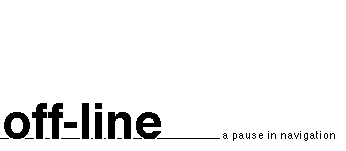 |
 |
August, 1999 |
 |
 |
August, 1999 |
| Giancarlo Livraghi gian@gandalf.it |
|
| |
||
|
I'm thinking again about Greek and Phoenician merchants. This isn't just historical interest. The fact is that old concepts, that have been around for many centuries, still work today. Every now and then someone dresses up one of those ideas as "new"; and the more it's encumbered with elaborate theories and techniques, the less it works. In the old days, merchants didn't think about "segmentation"; but they knew that they couldn't sell everything to everybody. They knew where to offer silk, perfumes and decorated vases – and where people were more interested in weapons and uniforms. It wasn't too difficult to keep markets separate, because things didn't change too often; each place had a fairly stable and distinct style and culture. Even more recently, only a few decades ago, is was relatively easy to "segment", because behaviors could be classified reasonably well by demographic criteria. And since Yankelovich, twentyfive years ago, invented "psychography", also by attitude and lifestyle. But now it's much more difficult to identify standard "segments". With computers came a new idea: data based marketing. At last, they said, we can aim at a "target group" with mathematical precision. But that's sooner said than done. It was soon found that databases aren't perfect, computers have bugs and human error (multiplied by Murphy's Law) can lead to embarrassing mistakes. Segmentation is a clumsy tool. We try to match a product or service with certain pre-determined "clusters" of people, that we have programmed into our computers, in order to reduce waste in distribution and communication. But the fit is very approximate and "optimization" isn't as close as it should be. Now it's getting worse, because people are less "segmentable". Attitudes and choices vary enormously and no longer fit into standards. There are indeed "mass" behaviors, such as spectator sports and discotheques, but most of the time people make their own decisions individually and don't follow the rules set by the segmentation theories. The same person can be innovative in technology and conservative in food – or vice versa. Some young people love Mozart, some old people prefer rock music. We find quite often that "heavy users" of a product or a brand can't be classified by any demographic (or psychological) standard. Is the internet a tool for better segmentation? Is it important to capture personal data and statistics behind people's backs so that we can "catalog" them more effectively? I don't think so. With interactive communication we can forget classification and clustering; we can get rid of the segmentation paraphernalia and concentrate on real people. We don't have to go chasing after people, trying to guess where and how we can find them. It's the other way round: they choose us. It's proven by research that people more willing to buy, or enter any transaction, online are not the newcomers. They are the more experienced users that feel more comfortable with the net, know their way around and are more active. If we know how to be unique, if we provide the right information in an interesting way, we don't need to select our audience and our customers. They do it for us, much more effectively than any "segmentation" tool that we could buy or conceive. Some people will find us and, if pleased, will tell others that are interested in what we have to say – or sell. Is that a slow process? Not really. Relations don't add, they multiply. And if things aren't too fast in the beginning, that's better. It gives us the time to experiment and learn, to improve and refine, before we are swamped with more than we can handle. |
||